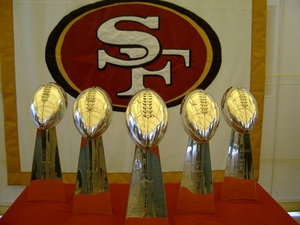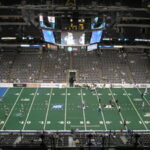SANTA CLARA, Calif. – When the 49ers enter the war room during the April draft, one of the biggest needs they will have to address is at wide receiver. This was a similar problem last year that was addressed with free agents Randy Moss, Mario Manningham and first round selection A.J. Jenkins.
As the team stands right now, Michael Crabtree represents the only consistency at the position the team has had. Manningham, currently the number two option, had caught only one touchdown in the 12 games he played before a season-ending knee injury. Jenkins, who caught no passes during the season, and Kyle Williams are the team’s third and fourth options with Randy Moss uncertain to return.
Should the 49ers return to the Super Bowl, the wide receiver position must be upgraded with at least one addition; maybe more. While a few veteran receivers are available, the 49ers will be sure to make at least one selection fairly early in the draft at the position.
San Francisco has 15 draft picks this year after the trade of backup quarterback Alex Smith to the Chiefs; most in the NFL. They have the 31st selection, the 34th (from Kansas City) and the 61st. With three picks in the first two rounds, the Niners have a plethora of options they could go with.
Let’s examine some of the top receivers that the 49ers could draft with their first three selections. All combine numbers and physical measurements are courtesy of NFL.com.
Cordarelle Patterson – Tennessee
6-2, 216 lbs
Ranked by ESPN as the top receiver in this class, Patterson played his first two years of his collegiate football at the community college level. He transferred to Tennessee after being a two-time JUCO All-American and becoming the top JUCO player in the country. During his one year at UT, Patterson made a huge impact with 778 receiving yards and five touchdowns. He ran the ball on occasion, averaging over 12 yards a carry, while amassing 308 rushing yards and three touchdowns. He also excelled as a returner, scoring on an 81 yard punt return, as well as a 98 yard kick return.
Patterson is an extremely gifted athlete who runs smooth, fluid routes. His speed allows him to break free deep while also being able to haul in difficult catches. As a runner, he has the ability to make plays out of nothing.
However, the Volunteers lined him up behind the line of scrimmage often because he does not handle bump-and-run defense very well. Also, he is not the most advanced of receivers when using his hands. He has a tendency to body catch, instead of extending his arms.
At the combine, Patterson ran the 40-yard-dash in 4.42 seconds, sixth among WRs, and had a vertical jump of 37 inches, which ranked fifth.
Cordarelle Patterson has drawn comparisons to Demaryius Thomas. He is likely going to be taken well before the Niners first pick, unless they move up.
Highlights can be found here.
Keenan Allen – California
6-2, 206 lbs
Allen may be one of the most well-known receivers to Niners’ fans with his collegiate home right across the bay in Berkeley. His 1343 receiving yards in 2011 ranked him ninth nationally, behind such names as Justin Blackmon and Kendall Wright.
He is the definition of a competitor, with the size and strength to make all of the tough catches. He is an excellent route runner who tends to find holes in zone coverage. Also, Allen has shown the willingness to block downfield, which is important to any team with a heavy run game.
Allen’s downfalls are that he can be slightly inconsistent with his hands. He drops relatively easy passes on occasion while seemingly losing focus. He is quick, but does not have elite top-end speed. Also his durability has some teams concerned, missing time last season with a knee injury.
Keenan Allen has been highly regarded since being a five-star recruit several seasons ago. He has drawn comparisons to Ravens’ receiver Anquan Boldin. He did not work out at the NFL combine.
Highlights can be found here.
Tavon Austin – West Virginia
5-8, 174 lbs
Austin is the definition of a play-maker. Among the most diverse players in all of college football, Austin contributed to a strong Mountaineers offense with receiving, rushing and returning.
During the last three years, he recorded over 3,000 receiving yards with 28 touchdowns. After making very little impact in the backfield between 2009 and 2011, he exploded as a runner in 2012 with 643 yards and three scores. He also had five career returns for touchdowns.
Austin is incredibly fast, recently running a 4.34 second 40-yard-dash. He uses his agility and quickness to break away from coverage with relative ease. He is an excellent runner with the ball in his hands, and racks up plenty of yards after the catch. His versatility would allow a team to use him in a multitude of ways. He also tends to play bigger than his body size would suggest.
The knock on Austin is that he is not tall enough or strong enough to play on the outside. As a WR, he is fairly limited to the slot, perhaps preventing him from truly ever emerging as a number one receiver. Also, his hands occasionally display poor fundamentals and needs to be coached up a bit.
While playing on national TV against the Oklahoma Sooners, Tavon Austin had 572 all-purpose yards, which is second most in FBS history. Performances like this allowed him to win the Paul Hornung Award as the nation’s most versatile player. Highlights of this game can be found here.
He is compared to players such as Percy Harvin and Randall Cobb.
Justin Hunter – Tennessee
6-4, 196 lbs
Hunter has the typical size usually associated with a number one receiver. He tore his ACL in 2011 during the third game of the season, but rebounded in 2012 playing in every game.
Last year, he hauled in 73 catches for 1083 yards and nine touchdowns.
He has a tall frame, long arms, and a great vertical leap (39.5 inches) which makes him a threat on jump balls. Even with his size, Hunter’s long strides make him deceptively quick as he recorded a 40 time of 4.4 seconds. He handles bump-and-run coverage well and can make catches in heavy traffic.
Unfortunately, Hunter’s hands were sometimes inconsistent in an otherwise successful season. While recording excellent numbers, most experts would agree he did not live up to his full potential last year. He does not seem interested enough in blocking downfield, and when he does, he is not physical enough to extend plays.
It’s believed that Hunter’s problems were more mental than physical, which can be looked at as better or worse depending on your view. He can be physically compared to A.J. Green but is tools-wise more similar to Kenny Britt according to SBNation.com.
Highlights can be found here.
Robert Woods – USC
6-0, 201 lbs
Robert Woods was a standout receiver during his time at USC. His chemistry with quarterback Matt Barkley was evident since his true-freshman season of 2010.
After a successful freshman year, Woods exploded in 2011 hauling in 111 receptions for 1292 yards and 15 touchdowns even with an injury plagued season. His touchdown total was good enough for fifth nationally. His numbers took a slight dip in 2012, albeit still very impressive, to 846 yards and 11 scores. Sophomore teammate Marquis Lee, the Biletnikoff Award winner, had a major role in Woods’ decline. He publicly announced his disapproval with taking on a lesser role, citing that as a major reason why he is leaving after his junior season.
Woods is an excellent possession receiver with great fundamentals and instincts. He runs excellent short to medium routes including curls, and often becomes a target when plays break down. He has great quickness and agility, allowing him to separate on deep balls. His ability after the catch makes him exceptionally dangerous with the ball in his hands.
However, the USC receiver does not possess the greatest upper-body strength. He does not seem to break away from jams at the line of scrimmage all too easily. Although recognized as a good overall deep-ball threat, Woods can lose his fundamentals when catching the ball down-field.
His 40 time of 4.51 seconds ranks him 16th among wide receivers. He is drawn comparisons to such players as James Jones and Reggie Wayne.
Highlights can be found here.







